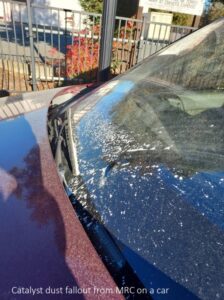A toxicologist hired by the County this week began collecting samples of soil that may have been exposed to metal-laden “spent catalyst” released by the Martinez Refining Company (MRC) into the surrounding community last Thanksgiving. (See related articles here, here and here)
Soil samples are being taken from more than a dozen sites, primarily areas neighboring the refinery in Martinez and Benicia. Collected samples will be sent to a lab to analyze for concentrations of metals associated with the catalyst that may pose risks to human health through skin contact, inhalation or from consuming produce grown in the contaminated soil. Lab results of the soil samples are expected in late May or early June.
“We know the community is eager to find out what’s in the soil in their yards and whether they should be concerned for their health,” said Supervisor Federal Glover, whose district includes the refinery, which is owned by PBF Energy Inc. “The soil testing will help provide residents with answers to those questions.”
The sampling plan was based in part on a plume model map created by the Bay Area Air Quality Management District that showed where the spent-catalyst dust likely traveled. The plan was reviewed and approved by the MRC Oversight Committee, which includes seven community residents, at its April 27 meeting.
The soil sampling and risk assessment are being done for the County by TRC, a Concord-based environmental consulting firm. The risk assessment will also compare levels of metals found in the sampled soil against background levels taken from published academic and regulatory sources.
On November 24-25, 2022, MRC accidentally released up to 24 tons of metal-laden spent catalyst dust into the surrounding community. MRC failed to notify the County about the incident, which the County learned about two days later from social media, as required by local policy. Initial wipe samples of the spent-catalyst dust taken from surfaces in neighborhoods around the refinery in the days after the accident showed elevated levels of certain metals, such as aluminum, barium, chromium, nickel, vanadium, and zinc.
The most acute health risk occurred at the time of the incident when people could have breathed in the dust and caused respiratory distress. Questions have persisted about possible long-term health impacts, particularly from food grown in potentially contaminated soil exposed to the spent catalyst.
In March, with spring and gardening season arriving, the County’s health officer issued an advisory cautioning residents not to eat food grown in potentially contaminated soil until environmental testing could be completed.
“Residents affected by this release deserve to know if there is any health risk. Contra Costa Health is working as quickly as possible to ensure that accurate information reaches the public about this issue,” said Board of Supervisors Chair John Gioia, who also serves on the Bay Area Air Quality Management District Board of Directors.
For more information on the risk assessment and independent investigation of the November 2022 incident, visit cchealth.org/hazmat/mrc.




Leave a Reply